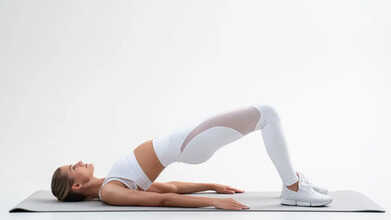- Health Conditions A-Z
- Health & Wellness
- Nutrition
- Fitness
- Health News
- Ayurveda
- Videos
- Medicine A-Z
- Parenting
- Web Stories
20-Minute Thigh Workout You Can Nail Without Getting Off The Floor

Image Credit: Canva
Short on time or just having one of those days when you don't want to move out of bed? It happens to the best of us. But what if you could still firm your thighs, build up your hips, and increase your lower-body strength without getting up off the floor? The 20-minute lazy-girl workout will do all of this and more for you with its simplicity and effectiveness.
This is a 20-minute lying-down thigh workout with no standing at all, and will zero in on the adductors, which are a crucial yet often neglected muscle group. This simple yet powerful moves, lie down and build strength, stability, and mobility in the lower body while lying down.
Why Focus on Thigh Strength?
These include the thigh, which bears adductors and abductors for a stable hip that keeps the muscles for strength. Most movements including running, lifting, and simple walks depend largely on the flexibility and power developed within the adductor and abductor muscles within your thighs. Their lack often means muscle imbalance and poor movement capability.
The adductors are located on the inner thigh, and their primary function is to pull your legs inward, which stabilizes your core and hips. This muscle weakness will also affect your posture and functional fitness. Balanced strength is always the focus in this workout; it ensures that both sides of your body are equal in strength—a critical injury prevention aspect.
Benefits of Lying-Down Workouts
Low Impact, High Efficiency
Working against gravity while lying down activates stabilizing muscles without putting stress on your joints.
Enhanced Core Engagement
Many of these exercises naturally recruit your core muscles, improving posture and overall strength.
Convenient and Accessible
Whether you’re at home, traveling, or simply pressed for time, this workout requires minimal space and no special equipment.
20-Minute Lazy-Girl Thigh Workout
1. Clamshell
Why it works: This exercise hits your glutes and inner thighs at the same time, which helps stabilize and strengthen your hips.
How to do it:
- Lie on your side with your head, hips, and heels aligned.
- Bend your knees and keep your feet together.
- Lift your top knee while keeping your feet glued, then lower back down.
Pro tip: Use a resistance band around your thighs for extra intensity.
2. Leg Raises
Why it works: This exercise targets your lower abs and inner thighs to build stability and strength.
How to do it:
- Lie on your back with your legs extended, palms flat on the floor at your sides.
- Lift both legs six inches off the floor.
- Lift one leg towards the ceiling then lower it and keep the other leg elevated.
Pro tip: To challenge yourself, add flutter kicks.
Also Read: Follow These 3 Simple Rules For A Slimmer Waist
3. Inner Thigh Raise
Why it works: This low-impact favorite zeroes in on the adductors with controlled motion.
How to do it:
- Lie on your side with one elbow propped up for support.
- Cross your top leg over your bottom leg, with your top foot touching the floor.
- Lift your bottom leg a few inches and lower.
Pro tip: Slow your movements for greater muscle engagement.
4. Side-Lying Leg Lift
Why it works: This dynamic exercise isolates the outer thighs (abductors) while improving hip mobility.
How to do it:
- Lie on your side with your supporting arm bent under your head.
- Stack your hips and lift your top leg toward the ceiling.
- Lower it with control, maintaining tension throughout.
Pro tip: Add a rolled-up towel under your hip for support.
How to Maximize Your Fitness
Consistency is Key: Perform this workout 3-4 times a week to build strength and endurance.
Use Props Wisely: Resistance bands and small cushions can intensify or support your movements, making the exercises adaptable for all fitness levels.
Pair with Lifestyle Tweaks: Combine these exercises with a healthy diet, regular cardio, and adequate hydration for optimal results.
Inner thigh strengthening will give you toned legs but, in reality, also helps to stabilize the core, prevents knee injuries, and improves athletic performance. It's like little engines working in the background that make sure you're safe and effective while you're moving around. This 20-minute thigh workout redefines fitness convenience, being adaptable to busy schedules or low-energy days, with its focus on core stability, hip strength, and functional mobility.
Disclaimer: This article is for informational purposes only and not a substitute for professional advice. Consult a healthcare provider before starting any new exercise routine.
5 Pelvic Floor Exercises That Can Transform Your Sexual Wellness

Credits: Canva
Your pelvic floor muscles do much more for your sexual health than most people realise. These deep muscles support the bladder, uterus, and bowel, but they also play a big part in pleasure, performance, and confidence during intimacy.
Whether you’re healing after childbirth, managing incontinence, or simply aiming to feel more connected with your body, training your pelvic floor is a natural way to improve sexual wellness.
What Is Pelvic Floor Exercise?
Pelvic floor exercises, often called Kegels, focus on strengthening the group of muscles that create a supportive sling for the bladder, bowel, and, in women, the uterus. They are done by contracting these muscles, as if stopping the passage of urine or gas, holding the squeeze, and then releasing. Regular practice can improve bladder and bowel control, enhance sexual health, and aid recovery following childbirth in women or prostate surgery in men.ALSO READ: Is It Safe To Have Sex With Heart Disease? Expert Tells 5 Things You Should Keep In Mind
Benefits of Pelvic Floor Exercise For Better Sexual Health
Pelvic floor exercises can make a real difference in your sexual life. As per Mayo Clinic, by strengthening the muscles that support the bladder, uterus, and bowel, these exercises improve blood flow and muscle control in the pelvic area. This not only enhances arousal and sensitivity but can also lead to stronger orgasms and better stamina during intimacy. For many people, a stronger pelvic floor helps reduce discomfort, boost confidence, and create a greater sense of connection with their body and partner.ALSO READ: Can A UTI Cause You Your Limbs? Explains Doctor
5 Pelvic Floor Exercises to Boost Sexual Health
1. Kegel Exercises
How to do it:- Squeeze the muscles you use to stop urinating.
- Hold for 5 seconds, then relax for 5 seconds.
- Repeat 10–15 times, two to three times daily.
2. Bridge Pose
How to do it:- Lie on your back with your knees bent and feet flat.
- Lift your hips upward while tightening your glutes and pelvic muscles.
- Hold briefly, then lower down.
3. Deep SquatsHow to do it:
- Stand with your feet hip-width apart.
- Lower into a deep squat, keeping your chest lifted.
- Engage your pelvic muscles as you come back up.
4. Bird-Dog
How to do it:- Begin on your hands and knees.
- Extend your right arm and left leg at the same time.
- Hold, then switch sides.
5. Pelvic Tilts
How to do it:- Lie on your back with your knees bent.
- Flatten your lower back into the floor by tilting your pelvis upward.
- Hold for a few seconds, then relax.
Love Playing Football? Studies Show That Footballers Face A Higher Dementia Risk

Credits: Canva
Football, the world’s most popular sport, may come with an invisible cost: brain health. While players are celebrated for their stamina, skill, and longevity on the pitch, research shows that elite footballers are more likely to develop dementia and related neurodegenerative diseases later in life compared with the general population.
The main factor? Heading the ball.
The Swedish Study: What It Found
A major cohort study, published in The Lancet Public Health in 2023, followed 6,007 male footballers who had played in Sweden’s top division between 1924 and 2019. Their health outcomes were compared with 56,168 men from the general population.
- 8.9% of footballers were diagnosed with a neurodegenerative disease versus 6.2% of controls.
- Footballers had a 1.46 times higher risk of developing these conditions.
- Alzheimer’s disease and other dementias were significantly higher among players, with a 62% increased risk.
- No increased risk was found for motor neuron disease.
Surprisingly, footballers had a lower risk of Parkinson’s disease.
But the most striking finding was the difference between player positions. Outfield players, who head the ball regularly, showed a 50% higher risk compared with the general population, while goalkeepers, who rarely head the ball, showed no significant increase in risk.
This position-based difference strongly suggests that repetitive head impacts, even those not causing concussions, play a central role in long-term brain health risks.
Confirming Earlier Evidence
These Swedish results echo a 2019 Scottish study published in The New England Journal of Medicine, which found that former professional footballers were 3.5 times more likely to die of neurodegenerative disease compared with controls. That study also highlighted that defenders, who head the ball most often, were at the greatest risk.
Together, these studies strengthen the link between heading the ball and higher dementia risk, adding to growing international concern about football’s long-term safety.
Also Read: 21-year-old Billy Vigar Of Chichester City Dies Of Sustaining Brain Injury
Why Football Differs From Other Sports
Sports like boxing, rugby, American football, and ice hockey are already well-known for head injury risks. However, football is unique because concussions are relatively rare (<0.1 events per 1,000 player-hours), yet players repeatedly use their heads to control and redirect the ball.
This creates frequent “sub-concussive impacts”, blows to the brain too mild to cause immediate symptoms but capable of triggering long-term neurodegenerative changes. Chronic traumatic encephalopathy (CTE), a condition linked to repeated head trauma, has already been identified in athletes from other collision sports. Football’s heading tradition may be creating similar risks.
Changing the Game: Calls for Action
- Recognizing these risks, football associations have started to act.
- In the UK, heading is restricted in children’s training sessions.
- UEFA has issued guidelines limiting headers in youth football.
- In England, rules now cap the number of high-force headers in training for adult professionals.
Experts, however, stress that these measures may not be enough. Tara Spires-Jones, professor of neurodegeneration at the University of Edinburgh, noted that the stark difference between outfield players and goalkeepers reinforces the link between head impacts and dementia. She emphasized that while sports and physical activity overall reduce dementia risk, avoiding repetitive head injury is crucial for brain protection.
Has Modern Football Changed the Risk?
One question remains: do today’s footballers face the same level of risk as those who played in the mid-20th century?
The Swedish study noted that most players diagnosed with neurodegenerative disease had careers before the 1970s. Since then, major changes have reshaped the sport:
- Leather balls, which absorbed water and became heavier, have been replaced by lighter synthetic ones.
- Training methods, tactics, and playstyles have evolved, potentially reducing—or even increasing—head trauma exposure.
- The modern game involves far more matches and intense training, meaning players may head the ball more frequently over a lifetime.
- Researchers caution that the long-term risks for today’s players remain uncertain, and ongoing monitoring is essential.
Should People Suffering From Migraines Exercise? Neurologist Answers

(Credit-Canva)
For people who suffer from migraines, even normal activities like concentrating on work, holding a conversation can be difficult. These are things we do not think twice about, however, simply going through these can be a major task for people who suffer with migraines.
So, what about exercising? It is an activity that requires a lot of movements, some of which require you to do movements that jerk your body like jumping jacks. Is it safe for people with migraines to work out? According to Dr Sudhir Kumar, a Hyderabad-based neurologist, the answer is yes.
Getting regular physical activity is hugely helpful for people who get migraines because it can often make your headaches happen less often and feel less painful when they do occur. While a super-hard, intense workout might seem like it would only make your head hurt more, exercising smart and making it a habit can be a very effective way to prevent future migraine attacks. However, there are some things you need to keep in mind before doing so.
How to Exercise Smartly to Prevent Migraines
To get the most benefit from working out and avoid accidentally causing a migraine, people need to be mindful of five simple rules:
Be Consistent, Not Extreme
It's the steady routine that pays off. Doing regular exercise at a medium effort level (moderate intensity) helps keep migraines away. On the flip side, sudden, super-tough, or "all-or-nothing" workouts—like running a marathon with no training—can shock your system and easily trigger an attack. The goal is to build a steady habit, like a morning walk or a bike ride a few times a week, rather than pushing yourself to exhaustion once a month.
Figure Out Your Personal Triggers
Everyone is different, and certain activities might be a trigger just for you. For instance, some people find that lifting very heavy weights causes a headache, while others get one from running outdoors on a very sunny day or simply forgetting to properly warm up their muscles. The best way to understand these unique headache causes is to keep a diary of your headaches and write down what you did right before the migraine started.
Watch the Clock (Timing Matters)
Doing a very intense workout right before bed, late in the evening, can make it hard for you to fall asleep or get good rest. Poor sleep is a well-known migraine trigger, so late-night intensity can create a double problem. To protect your sleep, it's generally best for migraine sufferers to plan their workouts for the morning or during the day.
Pick the Right Environment
Your surroundings can put stress on your senses. To avoid this sensory strain, choose a workout spot that is comfortable. Cool, well-aired rooms with soft lighting are much better than places that are hot, stuffy, or have bright, intense lights that can make your head ache worse.
Try Adding Mind-Body Activities
You can actually increase the headache-fighting power of your physical activity by adding calming practices. Things like yoga, deep breathing exercises, and mindfulness meditation are great because they help you manage stress and relax tight muscles in your neck and shoulders, both of which are common contributors to migraine pain.
Do Aerobic Exercises Help Migraines?
Dr. Sudhir explains that scientific research has repeatedly shown that regular aerobic exercise—that's any activity that gets your heart pumping, like brisk walking, cycling, or swimming—is highly effective. The recommendation is to aim for a moderate effort level, for about 30 to 40 minutes, three times a week. In fact, some studies suggest that doing this type of exercise consistently can reduce the frequency and severity of migraines just as well as certain preventive medications. The very best approach combines this steady cardio with gentle strengthening and stretching exercises for your neck and shoulders.
© 2024 Bennett, Coleman & Company Limited

